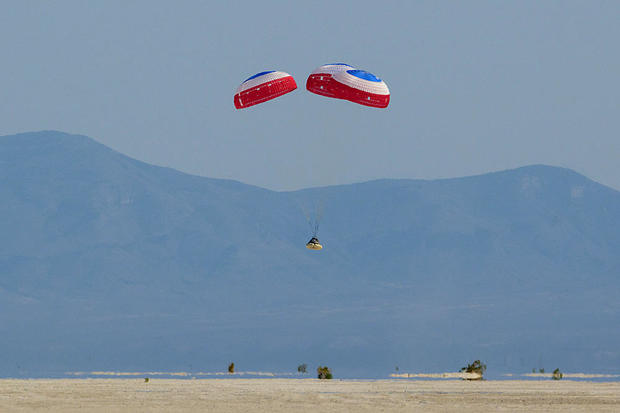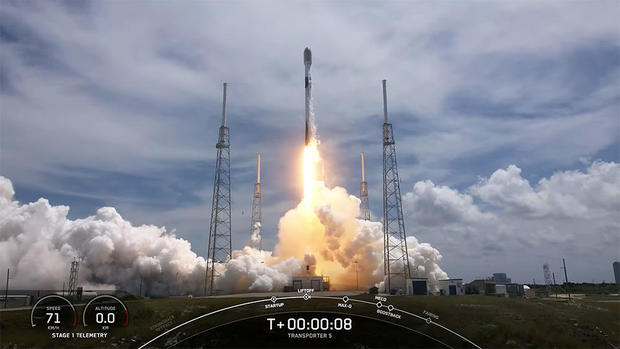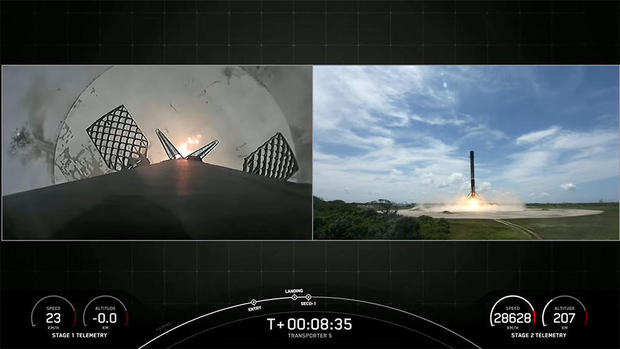Boeing's Starliner crew capsule returns to Earth after successful test flight
In a banner day for America's space industry, SpaceX launched 59 small payloads aboard a Falcon 9 rocket Wednesday while Boeing's Starliner crew capsule undocked from the International Space Station and flew itself to a picture-perfect landing in New Mexico to close out a successful unpiloted test flight.
"What an incredible day it was today," said Steve Stich, manager of NASA's Commercial Crew Program. "The test flight was extremely successful. We've met all the mission objectives. And of course, today was a big one with the undocking, the separation sequence and then the deorbit burn, entry and the landing.
"I'd like to congratulate the entire Boeing and NASA teams that have worked so hard on Starliner for many, many, many years."
The Falcon 9 blasted off from pad 40 at the Cape Canaveral Space Force Station at 2:35 p.m. EDT, climbing away atop 1.7 million pounds of thrust. The first stage, making its eighth flight, successfully landed back at the launch site eight-and-a-half minutes later. All 59 payloads reached the intended orbit.
While SpaceX was managing its 22nd flight so far this year, the Starliner capsule undocked from the space station's forward port at 2:36 p.m., one minute after the Falcon 9 blasted off. Four hours and 13 minutes later, after a fiery plunge back to Earth, the spacecraft settled to an on-target touchdown at White Sands Space Harbor, New Mexico, to close out a six-day flight.
It was a long-awaited triumph for Boeing, more than two years after the Starliner's initial test flight in December 2019 suffered embarrassing software and communications glitches that prevented rendezvous and docking with the space station. An attempted reflight in August 2021 was scrubbed due to corroded propulsion system valves.
This time around, with multiple upgrades and fixes in place, the capsule chalked up a solid performance, docking with the space station the day after its May 19 launch atop a United Launch Alliance Atlas 5 rocket.
"On a scale of 1-to-10, I think I'd give it a 15," said Boeing Vice President Mark Nappi, manager of the Starliner program. "This was incredible. We wanted to learn. We did. The team reacted to everything that was thrown at them perfectly. The vehicle reacted to changes like it was supposed to. The flight software worked in an excellent manner. We couldn't have asked for a better mission. It was truly a fantastic test flight."
While flight controllers ran into a few relatively minor problems with thrusters and the spacecraft's cooling system along the way, the Starliner's navigation, flight control, communications and other critical systems appeared to work well, raising hopes Boeing may be able to launch astronauts on a piloted test flight to the ISS before the end of the year.
"I don't see any reason why we can't proceed toward the crewed flight test next," Stich said. "We have a few things to work on between now and then. But I don't really see any show stoppers."
NASA is especially eager to get the Starliner certified for operational crew rotation missions to provide redundancy and assured access to space in case of a launch mishap, abort or other problem that might ground a rocket system and otherwise prevent U.S. astronauts from reaching the station.
When the space shuttle Columbia broke apart during re-entry in 2003, NASA was unable to launch astronauts for two-and-a-half years and was forced to buy seats on Russian Soyuz spacecraft until the shuttle returned to flight.
With two U.S. providers, NASA managers are confident the agency can keep the station staffed as required with U.S. and partner-agency astronauts throughout the life of the program.
SpaceX, of course, is equally critical to NASA's plans and the company continued its blistering launch pace Wednesday as its latest Falcon 9 climbed smoothly away from Cape Canaveral and into its planned initial orbit. It was the 156th launch of a Falcon 9 and the fifth so far this month.
The well-traveled first stage landed back at the Cape Canaveral Space Force Station after boosting the upper stage and payload out of the dense lower atmosphere, chalking up the company's 121st successful booster recovery and its 23rd in Florida.
The second stage, meanwhile, was expected to reach its final orbit 56 minutes after launch.
On board were 59 small satellites and other payloads making up SpaceX's fifth dedicated Transporter "rideshare" mission, part of a company initiative to provide low-cost access to space for smaller satellites that might otherwise have problems hitching rides on higher-priority missions.
The Transporter 5 manifest included "CubeSats, microsats, non-deploying hosted payloads and orbital transfer vehicles," SpaceX said, of which 41 were to be deployed. All were expected to be released from the Falcon 9 second stage within an hour and 15 minutes of launch.
for more features.




